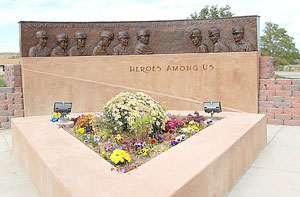Crandall Canyon Mine Monument
Sept. 14, Huntington city was gifted with a monument, dedicated to the six miners and three rescue workers who died in the Crandall Canyon Mine disaster. The monument is adjacent to the Huntington City Cemetery and near Canyon View Junior High School. When standing in front of the memorial site, one can see Huntington Canyon and Crandall Canyon, where the miners are entombed.

This archived article was written by: Tylor Christmas
Sept. 14, Huntington city was gifted with a monument, dedicated to the six miners and three rescue workers who died in the Crandall Canyon Mine disaster. The monument is adjacent to the Huntington City Cemetery and near Canyon View Junior High School. When standing in front of the memorial site, one can see Huntington Canyon and Crandall Canyon, where the miners are entombed.
The monument is the work of Karen Templeton with the assistance of fellow sculptor and friend Lisa Chamberlain. Karen is the wife of Kent Templeton, an English teacher on campus, and was a member of CEU’s nursing administration before pursuing a full-time career in art.
The monument is 16-feet long and about six-feet tall. It depicts the six miners facing the three rescue workers. Karen calls the piece Heroes Among Us.
To capture the likeness of a miner, Kent modeled for his wife in a miner’s uniform, borrowed from a neighbor, and a helmet, given to them by the mine. To capture the faces of the miners, Templeton used pictures of the deceased given to her by the families. The process was time consuming. Constant modifications were made at the families’ request until the sculpture accurately satisfied their memories.
Karen was commissioned to build the sculpture in October last year, and the finished mold was scheduled to go to the Metal Arts Foundry in Lehi to be poured as bronze in May. This gave Karen only eight months to complete this difficult task.
The sculpture is a bas-relief sculpture, which Kent says is more difficult than a 360 degree bust because you are given very little space to capture the whole essence of a person.
Karen’s training as a nurse proved useful in that she used her knowledge of human anatomy to make the sculptures seem as life like as possible. While molding the sculpture, Karen read for hours about the anatomy of the human face.
Experience in caring for persons with severe spinal injuries helped Karen empathize for people. Her sympathy for human suffering is projected through her work.
The sculpture was particularly difficult because it is laid across a curved concrete wall. This was expensive and posed a challenge to the contractors. However difficult, the curve is a significant part of the monument. It symbolizes the mountain enclosing around the miners, as if hugging them.
The sculpture was commissioned by the city of Huntington and financed by Gov. Jon Huntsman and other private donors. The sculpture is placed on the concrete so the miners’ eyes are about six feet off the ground, so that most people are eye level with them. Karen believes that the soul of a person resides in their eyes.
Karen has several finished works around the community, including the stain glass window at Helper Junior High, a paper sculpture mobile of petroglyphs at the CEU prehistoric museum and a 10-feet tall, glass and steel petroglyph in Grand Junction, Colo.
Karen went to Columbia University in New York where she trained for her LPN and RN. Afterward, she studied at the University of Arizona where she received her master’s degree in nursing. Karen taught nursing for several years at CEU, but thought it more gratifying to pursue a career in sculpting. Karen is mostly self-taught, however, she studied with a French sculptor for a small block of time in France.
Four different ideas were pitched about how the memorial should look. The families of the miners and rescue workers voted that Karen’s sculpture best represented their loss and the miners’ depth of love for the community. To turn the sculpture into bronze, the piece had to be cut in half for transportation, and then cut into 10 separate pieces to be bronzed. It was then welded together. This process alone cost $40,000.
Karen is currently working out of her eco-friendly studio in her and her husband’s backyard. It is made mostly of straw bails and plaster and is two stories high. For more information about Karen’s sculptures, go to her website Templetonsculpure.com




